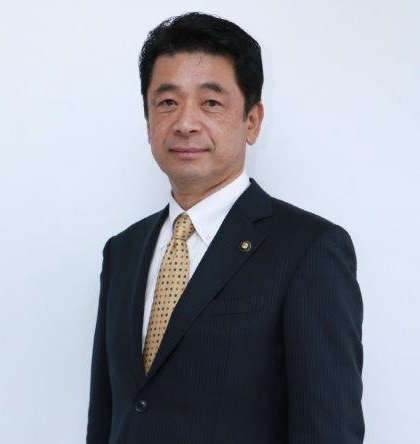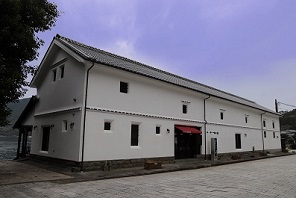PEOPLE
I wish to pass on to my children's generation the wisdom, technology, and energy of our ancestors who built Misumi West Port - I will do my very best to do what I can at this moment by looking ahead to the future that will surely come after COVID-19.

Mayor of Uki City, Kumamoto Prefecture
Born in 1959 in the town of Ogawa-cho, Shimomashiki District, currently known as Ogawa-cho, Uki City, Kumamoto Prefecture.
Graduated from Chuo University in 1983 with a degree in law, and while working as a judicial scrivener and Chairman of a nursing home, he was first elected to the Kumamoto Prefectural Assembly in 2003, serving three terms of ten years.
He was first elected mayor of Uki in February 2001 and is currently serving his third term at the age of 62.
Misumi West Port located in Uki City, Kumamoto Prefecture, was one of the three largest ports built in the Meiji period, along with Nobiru Harbor in Miyagi Prefecture and Mikuni Port in Fukui Prefecture. The construction of the port began when then prefectural governor, Mr. Keimei Tomioka, focused on the construction of a trading post. It was designed by Rouwenhorst Mulder, a Dutch hydraulic engineer dispatched by the Meiji government, and constructed by stonemasons from the city of Amakusa. After three years of construction, the port was opened in 1887. About 130 years have passed since then, and the port still retains its original appearance.
Reasons Behind Why Misumi West Port was Highly Evaluated as One of the Component Parts
Kato Of the three major ports built in the Meiji period (1868-1912), Misumi West Port is the only one that still exists today, and its 756-meter-long masonry wharf and waterway were designated an Important Cultural Property of Japan in 2002. I've visited the city of Uki several times and it is a really lovely place with a Dutch-like ambiance and a touch of the Meiji era. Just crossing the Five Bridges of Amakusa and driving along the coastline is enough to get you excited. It is probably the most beautiful place in the Group of Sites of Meiji Industrial Revolution. It is also wonderful to see the remains of quaint buildings such as the Ryu-jo Kan and the old Misumi Shipping Warehouse. I sincerely hope that many people will visit the site.
Morita Thank you very much. The Ryu-jo Kan now serves as a guidance facility for the Misumi West Port and Sites of Japan’s Meiji Industrial Revolution.
The former Misumi Shipping Warehouse was restored in 1988 and reinforced last year, and is now being used as a restaurant. The restaurant is popular at all times of the day, but it is mainly known for its particularly beautiful sunset from the terrace.
The town area also still has some buildings left from the past. It is home to some of the most technologically advanced buildings of the time, such as the old Udo District Office and the old Misumi Summary Court. It is also widely known as the filming location for the NHK drama "Clouds over the Hill" and two movies “Rurouni Kenshin: Kyoto Inferno” and "Rurouni Kenshin: The Legend Ends."

Kato I see. It is certainly an ideal location for a film about Japan at the end of the Edo period. However, the most impressive thing is the Misumi West Port. It was selected as one of the component facilities of the "Sites of Japan’s Meiji Industrial Revolution" in recognition of two major facts: it is a port city built by the accumulation of traditional Japanese stone-cutting techniques of carving mountains and reclaiming the foreshore, and the fact that the rational development of urban infrastructure is still almost completely intact.
Morita In 1889, the Misumi West Port was designated as a special port of export by the Japanese government and began to export five commodities: rice, wheat, wheat flour, coal, and sulfur. Thus, it prospered as one of Kyushu’s major distribution or trading centers. Coal, in particular, was transported from Miike Coal Mine to Misumi West Port, where it was reloaded onto large steamships for export to Shanghai, China.
Kato I see, so it is for this reason that the Misumi West Port was instrumental in the development of the coal industry and, in turn, was deeply involved in the industrial revolution of Meiji Japan.
Representative Director, National Congress of Industrial Heritage
(Honorary Advisor, Kyushu Railway Company (JR Kyushu)
Senior Researcher, Industrial Heritage Information Centre
Honorary Advisor, Nippon Mining Co., Ltd.
The Ambassador of Supporting Kamaishi Hometown
Former Director of Nagasaki City World Heritage Office
Former General Manager, Nagasaki Shipyard and Machinery Works, Mitsubishi Heavy Industries, Ltd.
Chairman, Fujisankei Group
Executive Managing Advisor, Fuji Television Network, Inc.
Executive Managing Advisor, Fuji Media Holdings, Inc.
Advisor, Federation of Japan Port and Airport Construction Association
(Ex. Chairman of Specialists Center of Port and Airport Engineering)
Mayor of Nagasaki City
Former Director of the Sano Tsunetami Memorial Museum (currently known as Sano Tsunetami and the Mietsu Naval Dock History Museum)
Director of NPO Association for Thinking about Satoyama
Director of National Congress of the Industrial Heritage
Honorary Chief Priest Toshinari Ueda
Former Mayor of Omuta City
Archaeologist and Heritage Conservation Specialist
A fellow of the Japan Federation of Engineering Societies
Team Member of the Industrial Project Team Office for the Promotion of World Heritage Listing under Cabinet Secretariat
Governor of Kagoshima Prefecture
Mayor of Hagi City
Mayor of Uki City, Kumamoto Prefecture
The Former Employee of Nippon Steel Corporation
An Associate Professor of the Faculty of Science and Engineering in Iwate University
Chairman of the Tourist Guide Association of Misumi West Port
President of Kuraya Narusawa Co., Ltd.
Chairman of Izunokuni City Tourism Association
Director and General Manager of Gunkanjima Concierge
Producer of the Gunkanjima Digital Museum
Owner at Tōge Chaya
Chairman: Mr. Hidenori Date
President: Mr. Masahiro Date
Proprietor, Houraikan Inn
Representative Director of Egawa Bunko non-profit incorporated foundation
The 42nd head of the Egawa Family
Democratic Party for the People (DPP) Representative for Nagasaki Prefecture
President of the NPO, Way to World Heritage Gunkanjima
Representative Director
MI Consulting Group
President of Watanabe Production Group and Honorary Chair of Watanabe Productions Co., Ltd.
Member of the House of Councillors
Governor
Kagoshima Prefecture
World Heritage Consultant
Director and Dean, The Kyushu-Asia Institute of Leadership
Representative Director, SUMIDA, Inc.
Journalist, founder of the Shimomura Mitsuko Ikikata Juku School
Representative, Rally Nippon
Chairman, Sites of Japan’s Meiji Industrial Revolution World Heritage Route Promotion Council Director, National Congress of Industrial Heritage
Representative Director, General Incorporated Foundation National Congress of Industrial Heritage (Advisor, Public Interest Incorporated Foundation Capital Markets Research Institute)
Mayor of Nagasaki City
Policy Director at Heritage Montreal
World Heritage Consultant
Executive Director of Kogakuin University
Heritage Architect and International Consultant
Head of Data Acquisition at The Glasgow School of Art’s School of Simulation and Visualisation
Head of Industrial Heritage, Historic Environment Scotland, Edinburgh
Scottish Ten Project Manager, Historic Environment Scotland, Edinburgh
Mayor of Izunokuni City, Shizuoka Prefecture
Pro-Provost and Chairman of Council of the Royal College of Art. Heritage advisor of Canal & River Trust for England and Wales.
Dean of Tokyo Rissho Junior College
Professor emeritus of Keio University
Mayor of Kitakyushu City
At the 39th session of the World Heritage Committee convened in Bonn, Germany, from June 28 to July 8, 2015, the decision was approved to inscribe the Sites of Japan’s Meiji Industrial Revolution on the World Heritage list.
At a celebratory party held to mark the occasion, some of the primary promoters of the project spoke of their joy in achieving their goal and of the trials and tribulations to getting there.
Director and Managing Executive Officer, Hanshin Expressway Company Limited
Member, Board of Directors, National Congress of Industrial Heritage
Vice-Governor of Shizuoka Prefecture
Mayor of Hagi City
Chairman, Tokyo Metro Co., Ltd.
Mayor of Omuta City
Deputy Director-General, Lifelong Learning Policy Bureau, MEXT
Former Counsellor, Cabinet Secretariat
Mayor of Kamaishi City
Member, Board of Directors, National Congress of Industrial Heritage Counselor, Shimadzu Limited
Chairman of the Consortium for the World Heritage Inscription of Modern Industrial Heritage (Kyushu-Yamaguchi) and governor of Kagoshima Prefecture (as of 2015)